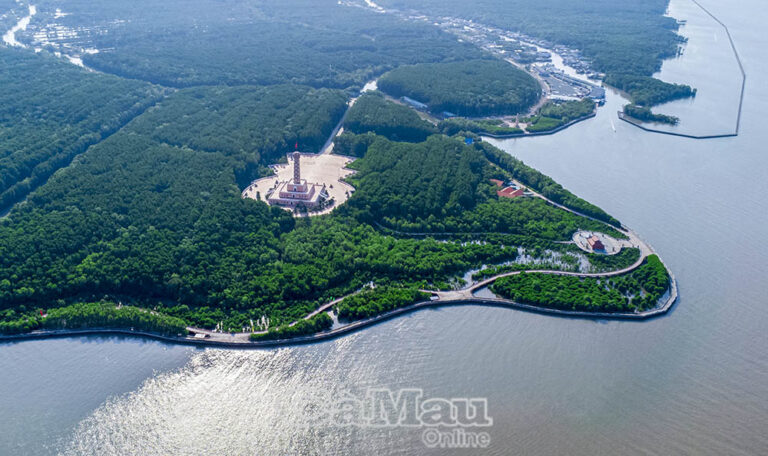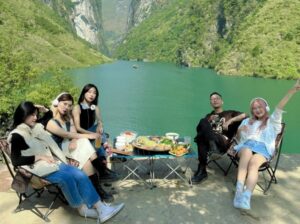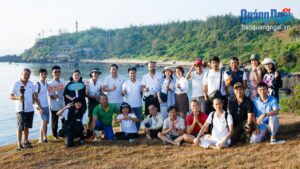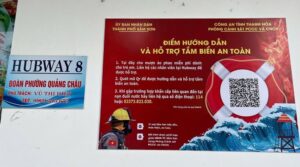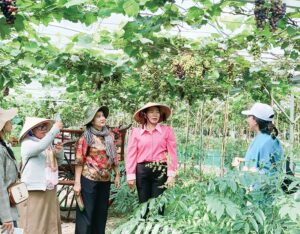To tap into multiple values from forests, many localities have effectively developed ecological tourism, increasing income for local people and contributing to education about conservation and sustainable development of the forest environment. This responsible experiential tourism model brings positive values to the economy, community and society.

Tourists visit the paperbark forest in Dong Thap Muoi (Long An). (Photo: Nguyen Cong Toai)
Unlike other types of tourism, forest tourism helps tourists experience and explore nature directly. Common activities in this type of ecotourism include hiking, mountain climbing, cycling, kayaking, cave touring and camping. Through these activities, visitors can immerse themselves in pristine nature, enjoy fresh air, and become more conscious about forest protection and natural environment conservation through personal experience and community promotion.
Attractive service types
Covering an area of nearly 10,000 hectares in Bac Kan Province, Ba Be National Park, possesses beautiful landscapes with Ba Be Lake, Dau Dang Waterfall, Fairy Pond, Puong Cave, Hua Ma Cave, Tham Kit Cave and so on, attracting thousands of visitors each year.
Meanwhile, Ba Vi National Park, with its rich historical and spiritual relics, mild climate, and diverse flora and fauna is becoming an attractive exploration destination, especially for experiential tourism among young people.
At Pu Mat National Park in Nghe An Province, organisations, individuals and businesses have built many forest-based ecotourism sites, creating jobs for approximately 200-300 local workers.
Nghe An Vice Chairman Nguyen Van De said that in recent years, Con Cuong (one of three districts where Pu Mat National Park is located) has become a destination for tourists nationwide. Besides attractions drawing many visitors, such as Pha Lai Dam, Moc Stream and Kem Waterfall, Con Cuong is appealing due to its unique culture, community tourism and the markets of Muong Qua and Muong Chon.
Con Cuong is one of the pioneering districts in developing community tourism models in Nghe An. According to experts, Pu Mat National Park is the core area of the Western Nghe An Biosphere Reserve recognised by UNESCO in 2007, a place with magnificent natural landscapes linked to the unique life and activities of the Dan Lai tribe.
With an area of nearly 17,000 hectares and a rich tourism complex, Pu Luong Nature Reserve in Thanh Hoa Province attracts thousands of tourists annually. To develop the economy in conjunction with sustainable forest management and protection, Thanh Hoa has approved an ecological tourism, resort and recreation project in the Pu Luong Nature Reserve until 2030, with a vision for 2045. Accordingly, the conservation area aims to welcome around 27,000 visitors, with revenue reaching over 33 billion VND by 2030.
Based on its biodiversity, natural landscapes, forestry scientific research achievements, conservation rescue results, indigenous community cultural values, and staff with continuously improved qualifications and skills, Cuc Phuong National Park has built a tourism ecosystem with many programmes and products. Cuc Phuong has been a leading destination for students, scientists, and domestic and international tourists.
Cuc Phuong National Park has a trans-forest tourism route with overnight stays in Muong villages, attracting many tourists and becoming a regular destination. Here, tourists can experience and learn about the life, culture, and indigenous knowledge of the community, hiking, swimming and rafting on the river, and evening cultural exchange activities.
Community tourism activities have created additional jobs, increased income, improved community living standards, raised awareness about nature conservation in the community, helped communities preserve certain cultural aspects and traditional crafts, and improved education through interaction with tourists.
In the process of implementing the task of forest economic development alongside sustainable forest management and protection, national parks, nature reserves and landscape protection areas have been doing well in eco-tourism activities and forest experiences.
According to the Forestry Department, income from forest tourism services of national parks amounts to approximately 2 trillion VND annually, bringing significant revenue for reinvestment in forest protection and management, and increasing income for people living near forests. Many national parks such as Cuc Phuong, Phu Quoc, Cat Tien, Nui Chua, Cat Ba, Ba Be, Yok Don, Con Dao and Pu Ma are becoming attractive destinations for tourists.
Improving tourism efficiency
Along with the 2017 Forestry regulating the principles of forest allocation, forest leasing and conversion of forest use purposes, there are now many new regulations on forest management and development suitable for promoting multiple forest values, including forest ecotourism businesses.
Functional agencies have transparently implemented forest management with local people's participation, respecting living spaces, customs and practices of community residents, prioritising forest allocation to ethnic minorities, households, individuals, and communities with customs, practices, culture, beliefs, traditions tied to forests, creating new linkage values from forests and attracting tourism development.
Notably, the Ministry of Agriculture and Environment recently implemented an initiative called National Park Passport. This creates a mechanism to promote ecological tourism development in national parks and nature reserves, creating motivation for tourists to experience and explore forest ecosystem values and gradually forming a sustainable financial mechanism and giving momentum for national parks and nature reserves with tourism infrastructure to have visitors, while attracting community attention to the sustainable values of the ecosystem.
Forestry Department Director Tran Quang Bao said that "National Park Passports" units will widely promote highly experiential forest tourism activities through the application, "passports" and sharing on the programme's communication channels. Based on tourism "passports", forest management boards, tourism facilities and localities will increase the number of visitors for experiences, promote locations and types of experiences to encourage tourists to collect points and promote the completion and diversification of tourism products.
Despite open mechanisms and policies, investment attraction in ecological tourism is currently limited, with low linkage and uniformity, and in many places, development is spontaneous and fragmented. The main reason is that localities have not identified tourism development as a common responsibility of the entire political system, all levels, sectors and society.
Forest-based tourism has specific characteristics: exploiting potential without destruction, using space without affecting the environment, travelling and experiencing to understand, propagate and mobilise communities to join hands in forest preservation and forest environment protection. Therefore, in addition to close linkages, localities must focus on developing diverse tourism products and actively raising awareness of forest protection.
According to Nguyen Van Thai, Director of Save Vietnam’s Wildlife, to effectively develop experiential tourism, it is necessary to raise awareness among buffer zone residents in conjunction with wildlife conservation work. Simply put, through school students, messages can be conveyed, such as "don't eat, don't hunt, don't use wildlife products directly sourced from nature".
On the other hand, national parks and nature reserves need to adjust and standardise programmes, service price lists, and implementation regulations, build a qualified guidance team to implement experiential education programmes and promote the participation of young people from cities and other areas.
Forest ecotourism is a type of tourism that is responsible towards the natural environment, has great potential and brings many benefits. Therefore, the state needs to have a correct and appropriate development orientation, minimising negative impacts on forests and the natural environment to increase the benefits of the natural environment to human life.


